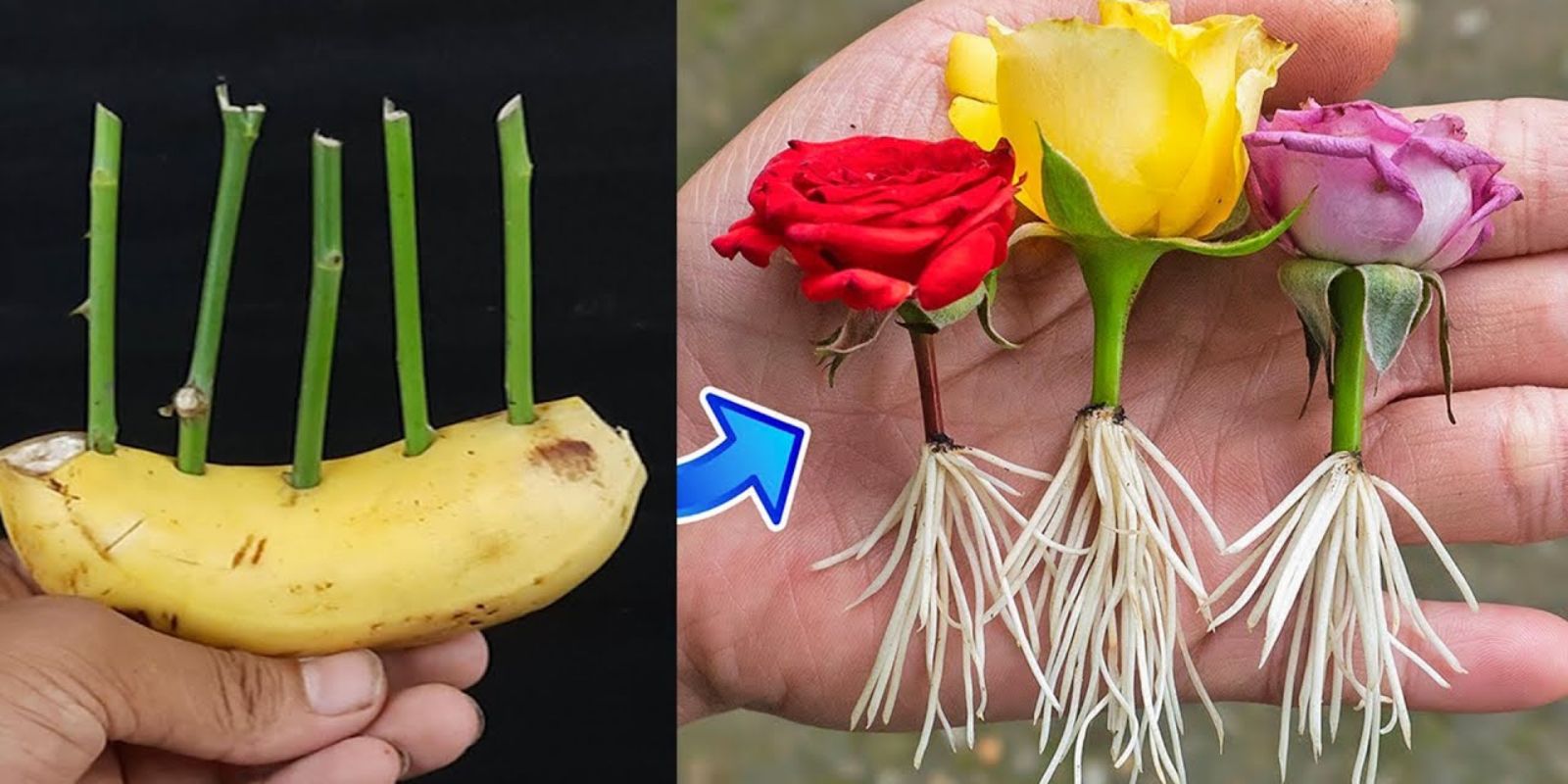Roses are the quintessential flower of romance and beauty, but growing them from cuttings can seem like a daunting task for many gardeners. However, with a little creativity and the right technique, you can propagate roses successfully at home. One innovative and eco-friendly method involves using banana peels and building sand—a technique that not only boosts your rose propagation success but also makes use of natural materials you might already have.
In this guide, we’ll walk you through the process of growing roses from cuttings using banana peels and building sand. This approach provides essential nutrients and growth hormones to help your rose cuttings take root and thrive. Whether you’re a beginner or an experienced gardener looking for new propagation methods, this step-by-step guide will ensure you get the best results.
Why Use Banana Peels and Building Sand?
Before we dive into the process, let’s understand why this method is so effective:
Banana Peels: Banana peels are rich in potassium and other essential nutrients that promote healthy root development. Potassium is vital for root growth, flowering, and overall plant health. The peels also contain natural growth hormones that help stimulate root formation in cuttings.
Building Sand: Building sand, when mixed with compost, creates a well-draining growing medium that is ideal for rooting rose cuttings. Proper drainage is crucial for preventing root rot and ensuring that the cuttings develop strong, healthy roots.
By combining these two elements, you create an optimal environment for your rose cuttings to thrive.
Materials Needed
To get started, gather the following materials:
- Healthy rose cuttings (6-inch sections)
- Banana peels
- Building sand
- Compost (optional, for added nutrients)
- Sharp knife or pruners
- Small pots or containers
- Plastic bags or domes
- Water
Step-by-Step Guide to Growing Roses from Cuttings
1. Prepare the Rose Cuttings
Selection: Choose healthy, non-flowering rose stems for your cuttings. The best time to take cuttings is during the growing season, typically in late spring or early summer.
Cutting Technique:
- Using sharp pruners or a knife, cut a 6-inch section from the rose stem.
- Ensure the cutting is made just below a leaf node (the point where a leaf attaches to the stem).
- Remove any leaves from the lower half of the cutting, leaving a few leaves at the top to reduce moisture loss.
2. Prepare the Banana Peels
Cutting the Peels:
- Cut banana peels into small, manageable pieces. These pieces will help provide essential nutrients and hormones to the cuttings.
Optional: You can blend the peels into a paste and mix them with water for a more concentrated nutrient solution, but small pieces work well too.
3. Prepare the Sand Mixture
Mixing:
- Combine building sand with a small amount of compost to create a well-draining medium. The compost adds some initial nutrients, but the sand ensures excellent drainage.
- A typical ratio is about 70% sand to 30% compost. Adjust based on your soil’s drainage needs.
Container:
- Fill small pots or containers with the sand mixture. Ensure the containers have drainage holes to prevent waterlogging.
4. Plant the Rose Cuttings
Insertion:
- Make a hole in the sand mixture using a stick or pencil. Insert the base of the rose cutting into the hole, ensuring it is buried about 2-3 inches deep.
- Place pieces of banana peel around the base of the cutting. These will decompose slowly, providing a steady supply of nutrients.
Watering:
- Water the sand mixture lightly to settle the cuttings. Be careful not to overwater; the sand should be moist but not soggy.
5. Cover and Maintain Humidity
Covering:
- To create a humid environment, cover the container with a plastic bag or dome. This helps retain moisture and creates a greenhouse effect.
- Ensure the cover doesn’t touch the cuttings to avoid mold growth. You can use sticks or small supports to keep the cover elevated.
Placement:
- Place the container in a warm, bright location with indirect sunlight. Avoid direct sunlight, which can cause overheating and dry out the cuttings.
6. Monitor and Water
Checking Moisture:
- Check the sand mixture regularly to ensure it remains moist. Water as needed, but be cautious not to overwater.
Ventilation:
- Occasionally remove the cover to allow fresh air to circulate. This helps prevent mold and ensures that the cuttings don’t become too humid.
7. Transplanting the Cuttings
Root Development:
- After about 6-8 weeks, check for root development by gently tugging on the cuttings. If you feel resistance, roots have formed.
Transplanting:
- Once the cuttings have developed a healthy root system, carefully transplant them into larger pots or directly into your garden.
- Prepare the new planting site with well-draining soil. If transplanting into pots, use a potting mix that includes sand or perlite for better drainage.
Acclimating:
- Gradually acclimate the new plants to outdoor conditions by placing them in a shaded area for a few days before moving them to their final spot.
Tips for Success
- Select Healthy Cuttings: Always use healthy, disease-free rose stems for the best results.
- Maintain Cleanliness: Ensure all tools and containers are clean to prevent the spread of diseases.
- Be Patient: Rose cuttings can take several weeks to root. Patience is key to successful propagation.
- Experiment: Try different rose varieties to see which ones root best with this method.
Conclusion
Growing roses from cuttings using banana peels and building sand is a creative and effective way to propagate these beautiful plants. With the right technique and a bit of patience, you can expand your garden with new rose plants that will bring beauty and fragrance to your outdoor space. This method not only makes use of natural materials but also provides a great learning experience for beginner gardeners.
Start your rose propagation journey today and enjoy the satisfaction of growing stunning roses from your own garden cuttings!

